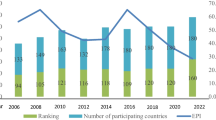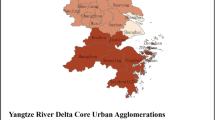Abstract
Environmental stress is used as an indicator of the overall pressure on regional environmental systems caused by the output of various pollutants as a result of human activities. Based on the pollutant emissions and socioeconomic databases of the counties in Beijing—Tianjin—Hebei region, this paper comprehensively calculates the environmental stress index (ESI) for the urban agglomeration using the entropy weight method (EWM) at the county scale and analyzes the spatiotemporal patterns and the differences among the four types of major functional zones (MFZ) for the period 2012–2016. In addition, the socioeconomic driving forces of environmental stress are quantitatively estimated using the geographically weighted regression (GWR) method based on the STIRPAT model framework. The results show that: (1) The level of environmental stress in the Beijing-Tianjin-Hebei region was significantly alleviated during that time period, with a decrease in ESI of 54.68% by 2016. This decrease was most significant in Beijing, Tangshan, Tianjin, Shijiazhuang, and other central urban areas, as well as the Binhai New Area. The level of environmental stress in counties decreased gradually from the central urban areas to the suburban areas, and the high-level stress counties were eliminated by 2016. (2) The spatial spillover effect of environmental stress increased further at the county scale from 2012 to 2016, and spatial locking and path dependence emerged in the cities of Tangshan and Tianjin. (3) Urbanized zones (development-optimized and development-prioritized zones) were the major areas bearing environmental pollution in the Beijing-Tianjin-Hebei region in that time period. The ESI accounted for 65.98% of the whole region, where there was a need to focus on the prevention and control of environmental pollution. (4) The driving factors of environmental stress at the county scale included population size and the level of economic development. In addition, the technical capacity of environmental waste disposal, the intensity of agricultural production input, the intensity of territorial development, and the level of urbanization also had a certain degree of influence. (5) There was spatial heterogeneity in the effects of the various driving factors on the level of environmental stress. Thus, it was necessary to adopt differentiated environmental governance and reduction countermeasures in respect of emission sources, according to the intensity and spatiotemporal differences in the driving forces in order to improve the accuracy and adaptability of environmental collaborative control in the Beijing-Tianjin-Hebei region.
Similar content being viewed by others
References
Barrett G W, Vandyne G M, Odum E P, 1976. Stress ecology. Bio-Science, 26(3): 192–194.
Brunsdon C, Fotheringham A S, Charlton M, 1996. Geographically weighted regression: A method for exploring spatial non-stationarity. Geographical Analysis, 28(4): 281–298.
Chen X, Zhou W Q, Han L J et al., 2016. Spatiotemporal variations of pollutant emissions and their relationship with the urbanization of the Beijing-Tianjin-Hebei region agglomeration. Acta Ecologica Sinica, 36(23): 7814–7825. (in Chinese)
Chen Z H, Leizhu J H, 2015. The spatial-temporal characteristics and economic drivers of environmental pollution changes in China. Geographical Research, 34(11): 2165–2178. (in Chinese)
Dinda S, 2004. Environmental Kuznets curve hypothesis: A survey. Ecological Economics, 49(4): 431–455.
Fang C L, 2014. Progress and the future direction of research into urban agglomeration in China. Acta Geographica Sinica, 69(8): 1130–1144. (in Chinese)
Huang L X, Wang H, Song L G, 2012. Is China’s industrial change green? Nankai Economic Studies, 164(3): 110–127. (in Chinese)
Kan D X, 2014. Empirical research on the impact of FDI to environmental pollution in China. Research of Environmental Sciences, 27(1): 106–112. (in Chinese)
Lazarus R S, Cohen J B, 1977. Environmental stress. In: Human Behavior and Environment. Springer US, 89–127.
Leeuw F, Moussiopoulos N, Sahm P et al., 2001. Urban air quality in larger conurbations in the European Union. Environmental Modelling & Software, 16(4): 399–414.
Li H N, Mu H L, Zhang M et al., 2011. Analysis on influence factors of China’s CO2 emissions based on Path-STIRPAT model. Energy Policy, 39(11): 6906–6911.
Li J, Zhuang G T, 2011. Features of Environmental Kuznets Curve (EKC) of output of major agricultural pollutants vs economic development level in China. Journal of Ecology and Rural Environment, 27(6): 19–25. (in Chinese)
Li K F, Wang J, 2017. Financial Agglomeration, industrial structure and environmental pollution: Spatial econometric analysis based on China’s provinces. Journal of Industrial Technological Economics, 36(3): 3–12. (in Chinese)
Li L G, Zhang P Y, Liu W X et al., 2019. Spatial-temporal evolution characteristics and influencing factors of county-scale environmental pollution in Jilin province, Northeast China. Chinese Journal of Applied Ecology, 30(7): 2361–2370. (in Chinese)
Li L Z, Fu Z Q, Wang Y H et al., 2017. Empirical study on manufacturing transfer and environmental impacts in Jing-Jin-Ji region. Research of Environmental Sciences, 30(12): 1813–1821. (in Chinese)
Liew J, Latif M T, Fredolin T et al., 2009. Spatio-temporal characteristics of PM10 concentration across Malaysia. Atmospheric Environment, 43(30): 4584–4594.
Lin X Q, Wang D, 2016. Spatio-temporal variations and socio-economic driving forces of air quality in Chinese cities. Acta Geographica Sinica, 71(8): 1357–1371. (in Chinese)
Liu H M, Fang C L, Huang J J et al., 2018. The spatial-temporal characteristics and influencing factors of air pollution in Beijing-Tianjin-Hebei region urban agglomeration. Acta Geographica Sinica, 73(1): 177–191. (in Chinese)
Ma L, Kang L, Jin F J, 2018. Spatial and temporal coupling relationship between industrial development and air pollutant emissions in Beijing-Tianjin-Hebei region. Environmental Impact Assessment, 40(5): 43–48. (in Chinese)
Ma S C, Li G Z, 2006. Kuznets curve of the relation between China’s economic growth and environmental pollution. Statistical Research, 23(8): 37–40. (in Chinese)
Miao H, Wang X K, Ouyang Z Y. 2001. Study on regionalization of eco-environmental stress process in China. Acta Ecologica Sinica, 21(1): 7–13. (in Chinese)
Ou X J, Zhen F, Qin Y D et al., 2008. Study on compression level and ideal impetus of regional urbanization: The case of Jiangsu province. Geographical Research, 27(5): 993–1002. (in Chinese)
Pan H F, Wang X, Zhang S Y, 2015. Duration and spatial spillover effects of haze pollution: Evidence from Beijing-Tianjin-Hebei region. China Soft Science, 30(12): 134–143. (in Chinese)
Qu F T, Zhao H X, Zhu D M et al., 2006. Regional difference in pollution and its cause in Jiangsu province. Resources and Environment in the Yangtze Basin, 15(1): 86–92. (in Chinese)
Rüttenauer T, 2018. Neighbours matter: A nation-wide small-area assessment of environmental inequality in Germany. Social Science Research, 70: 198–211.
Sha L, 2016. 1341 enterprises shut down and quit in Beijing in the past three years. Beijing News, 2016-11-13. (in Chinese)
Shen Y, Zhang L P, Fang X et al., 2019. Spatiotemporal patterns of recent PM2.5 concentrations over typical urban agglomerations in China. Science of the Total Environment, 655: 13–26.
Sui X Y, Wu W, Zhou S L et al., 2015. Drive pattern on the spatial heterogeneity of residential land price in urban district: A comparison of spatial expansion method and GWR model. Scientia Geographica Sinica, 35(6): 683–689. (in Chinese)
Sun K, Xu Z M, Song X Y et al., 2017. Spatial heterogeneity estimation of the impacts of human factors on environmental pollution in Chinese provinces. Acta Ecologica Sinica, 37(8): 2588–2599. (in Chinese)
Wang F, Dong S C, Mao Q L, 2014. Evolution of China’s industrial structure and spatial-temporal differentiation in environmental effect. Geographical Research, 33(10): 1793–1806.
Wang Y, Liu H W, Mao G Z et al., 2017. Inter-regional and sectoral linkage analysis of air pollution in Beijing-Tianjin-Hebei (Jing-Jin-Ji) urban agglomeration of China. Journal of Cleaner Production, 165: 1436–1444.
Wei L, Pan A, 2016. Do export and FDI aggravate environmental pollution in resources-based cities? An empirical analysis based on panel data of 285 prefecture cities in China. Journal of Natural Resources, 31(1): 17–27. (in Chinese)
Xu H, Yang Y, 2017. Impact of population and industrial agglomeration on environmental pollution: A case study of 100 cities in China. Urban Research, 2017(1): 53–60. (in Chinese)
Yan H, Guo Y G, Lin F C, 2010. Analyzing the developing model of Chinese cities under the control of CO2 emissions using the STIRPAT model: A case study of Shanghai. Acta Geographica Sinica, 65(8): 983–990. (in Chinese)
Yu Y Z, Liu F J, 2017. Impact of spatial agglomeration of productive services on environmental pollution. Research on Financial and Economic Issues, 39(8): 23–29. (in Chinese)
Zhang L, Chen W, Chen X et al., 2011. Space-time Analysis on delinkage between environmental pollution and economic growth in Yangtze River Delta. China Population, Resources and Environment, 21(Suppl.1): 275–279. (in Chinese)
Zheng X X, Li L J, Zhao W J et al., 2014. Spatial and temporal characteristics of atmospheric NO2 in the Beijing-Tianjin-Hebei region. Ecology and Environmental Sciences, 23(12): 1938–1945. (in Chinese)
Zhou K, Fan J, 2016. Regional disparity of environmental pollution source and its socio-economic influencing factors: Based on the cross-section data of 339 cities at prefecture level or above in China. Acta Geographica Sinica, 71(11): 1911–1925. (in Chinese)
Zhou K, Fan J, Liu H C, 2017. Spatiotemporal patterns and driving forces of water pollutant discharge in the Bohai Rim Region. Progress in Geography, 36(2): 171–181. (in Chinese)
Zhou K, Liu H C, Wang Q, 2019. The impact of economic agglomeration on water pollutant emissions from the perspective of spatial spillover effects. Journal of Geographical Sciences, 29(12): 2015–2030.
Zou H, Duan X J, 2016. Pattern evolution of economy-environment coordinated development in the Changjiang River Economic Belt. Scientia Geographica Sinica, 36(9): 1408–1417. (in Chinese)
Author information
Authors and Affiliations
Corresponding author
Additional information
Foundation
National Natural Science Foundation of China, No.41971164, No.42071148; Strategic Priority Research Program of the Chinese Academy of Sciences, Grant No.XDA23020101
Author
Zhou Kan (1986—), PhD and Associate Professor, specialized in resources and environmental carrying capacity and regional sustainable development.
Rights and permissions
About this article
Cite this article
Zhou, K., Yin, Y., Li, H. et al. Driving factors and spatiotemporal effects of environmental stress in urban agglomeration: Evidence from the Beijing-Tianjin-Hebei region of China. J. Geogr. Sci. 31, 91–110 (2021). https://doi.org/10.1007/s11442-021-1834-z
Received:
Accepted:
Published:
Issue Date:
DOI: https://doi.org/10.1007/s11442-021-1834-z




